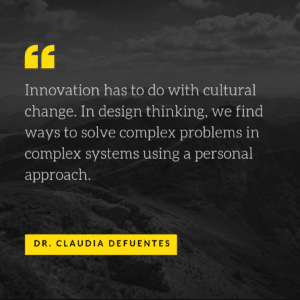Differentiation through Innovation
Innovation is a key to survival for many communities, particularly rural communities. Many small communities are struggling to find their differentiation or niche area in a competitive global environment where ‘standing out’ is becoming imperative for remaining relevant to your residents. As someone who grew up in a beautiful small community in Nova Scotia, I understand the challenges these communities face. I believe innovation, in thought and application is critical to positive change and growth for rural communities.

Claudia was my innovation professor during the Masters Technology Entrepreneurship and Innovation program at Saint Mary’s University. She was also my thesis advisor, and such a wealth of knowledge on global innovation and processes of innovation. It was in my first Masters class with Claudia that I developed a love for design thinking.
Innovation for Rural Communities
I recently attended an ‘Innovation Fete’ in the rural community of Yarmouth, Nova Scotia. This event was an opportunity for government, business, educational institutions and community stakeholders to gather and celebrate local innovations, while participating in discussions on innovation resources and practices in the province. There were presentations, panel talks and opportunities to network and discuss collaborations. I was impressed by the messages of local businesses growing through innovations, including a brewery which developed its own mechanism for creating consistent carbonation in their beer and a fisheries business marketing a new type of lobster trap with input from local fishermen. As one panelist commented “sometimes smaller communities are better environments for innovation because there is not as much competition and there is greater room for innovative impact.”
Design Thinking
Innovation was the most exciting topic in my Masters, and I was engrossed by the work we did in design thinking in particular. Design thinking is essentially human-centered processes for discovering and developing new innovations. I learned alot about this concept through the work of IDEO, a global firm working in areas of design thinking. I follow their blog and have been hooked on their work ever since. As Tim Brown explained in his paper on Design Thinking, “As more of our basic needs are met, we increasingly expect sophisticated experiences that are emotionally satisfying and meaningful.” (T. Brown, June 2008).
You can read more about the work of IDEO here.
When I see an opportunity to attend a local function focusing on innovation, I try to participate. I love to see innovation in action. As much as I enjoyed seeing such a large group of Nova Scotians gather to discuss innovation and network at the Innovation Fete, I was disappointed that the event did not touch on design thinking concepts as a way to address issues of innovation in rural communities. This process of discovery and experimentation is arguably one of the best ways to get the buy-in from community members when discussing how to innovate processes, products and communities, as it is an easy concept to understand and apply, and can traverse across abilities, positions and interests of participants in the process. Design thinking literally has something for everyone – whether you are a dreamer/creative type or an analytical thinker. Design thinking encourages diverse thinking and application using tools including visualization, journey mapping (customer discovery), value chain analysis, rapid product development, testing of assumptions, prototyping, gathering feedback and analyzing feedback and storytelling.
Design thinking follows three important steps; inspiration (observation, questioning, research), ideation (frameworks, brainstorming, prototyping) and implementation (testing, execution, strategy). The process is usually followed by a repeat of steps to further develop the innovation, or moving on to the next idea.
The Future
There is a tremendous opportunity for organizers of these innovation events to apply principles of design thinking to get greater buy-in from attendees. I would love to see an innovation event apply some truly innovative principles to shake people up. Harnessing the true potential of people will happen when we stop doing the same thing over and over (ie. put alot of people in a room, make them sit and listen to speakers and then expect them to be innovative), and start applying what we are talking about, ie. innovation. I do think that somehow, we are missing real opportunities to tap into that collective brain power. I’m attending another innovation event on November 3rd at the Coady Institute at St. Francis Xavier University called the Social Innovation Lab, and I will do a follow-up post after that event to further explore how we are tackling innovation across communities and industries in Nova Scotia.
References:
DeFuentes, Claudia, MTEI 5530, Saint Mary’s University, September 4, 2015.
Brown, Tim, Design Thinking, Pages 4, 8, Harvard Business Press, June 2008.
Martin, Roger, The Knowledge Funnel, Pages 4, 11, Harvard Business Press, 2009.
Liedtka, Jeanne M. & Ogilvie, Timothy, Ten Tools for Design Thinking, Page 1, 2, 5, 12, University of Virginia Darden School Foundation, Charlottesville, VA, 2010.

